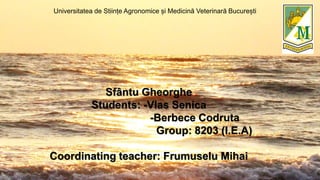Microsoft power point-presentation-nou
- 1. Sf├óntu Gheorghe Students: -Vlas Senica -Berbece Codruta Group: 8203 (I.E.A) Coordinating teacher: Frumuselu Mihai Universitatea de Stiin╚øe Agronomice ╚Öi Medicin─ā Veterinar─ā Bucure╚Öti
- 2. Sfântu Gheorghe (Turkish: Kadirlez) is a commune in Tulcea County, Romania. It is located at the end of the southern arm of the Danube near the Black Sea, in the Dobruja region. It is composed of a single village, Sfântu Gheorghe.
- 3. House in Sfântu Gheorghe Port of Sfântu Gheorghe Sfântu Gheorghe has a center with a town hall, a pub and some food stores. It is surrounded by one- storey houses, some of them have a Byzantine influence.
- 4. Inhabitants fish and work as tourist guides for visitors of the channels of the Danube.
- 5. Sf├óntu Gheorghe hosts the ŌĆØAnonimulŌĆØ International Independent Film Festival.
- 7. ’üĄ ANONIMUL International Independent Film Festival is organized by an extremely experienced team, and is spearheaded by Miruna Berescu - Festival Director from the very first edition. ’üĄ Film curator Ludmila Cvikova puts forward the selection for the Feature Competition (since 2008). She has worked as a programmer at the Rotterdam International Film Festival and as Head of International Programming at the Doha Film Institute. ’üĄ Film critic Irina-Margareta Nistor puts forward the selection for the Fiction and Animation Short Competition. For each edition, she sees around 400 films from all over the world, and chooses some 50 films for the audience in the Danube Delta.
- 9. WEATHER IN THE DANUBE DELTA The Danube Delta has a temperate climate, the area is sunny almost all the time as it is the least foggy area in the country with weak rainfalls (annual average: 400). July average temperature: 27Ōü░C; September: 23Ōü░C. Air moisture may vary from 85% during winter to 70% in summer. The snow layer is thin and only resists for short periods of time during rough winters. Dominant winds blow from the northern sector (North Wind).
- 11. DANUBE DELTA FLORA The largest wetland in Europe, including one of the largest expanses of reed in the world, Delta is dominated by the reed that forms fixed or floating islands of vegetation (reed). It is compounded by other riparian plants and plaur: bulrush, water fern, watercress, mint frog, water hemlock, sedges, mint, knot grass, dwarf willow. The sand areas of the Delta are covered with grass and other steppe species: the white willow, poplar, alder, ash, mixed woods on the banks. The water surface is populated by numerous species of plants with floating leaves: white water lilly yellow, grass frogs, ciulinele water, water language, rizacul, cornacul, sickle.
- 12. PISCES In the Danube Delta there are over 110 fish species, including 75 freshwater species. A special place among the Danube Delta fish species is occupied by sturgeons: stellate sturgeon, beluga sturgeon. Among the migratory fish, the most important is mackerel. Catfish is the biggest fish in the freshwaters of Romania, in the Delta record of 400 kg. The pike record is 21 kg. Other highly appreciated by fishermen fish are pike, carp, crucian, rapacious carp, perch, roach, bream, tench. In the Delta lakes you can fish pike and perch, carp, catfish, etc. On the DanubeŌĆÖs channels you can catch mostly catfish, carp, pike, perch, bream etc. The Danube main arms are preferred by starlet, bleak, beluga, sturgeon, stellate sturgeon, shad, carp, perch, pike, barbel, rapacious; calmer waters are populated by crucian carp, perch, bream and the salt waters by the bass, pike, mullet and flounder. The marine beluga sturgeon holds majority and the Pontic shad.
- 13. BIRD SPECIES In the Danube Delta lies the largest colony of pelicans in Europe. Pelicans, egrets, swans, cormorants, herons, ducks and wild geese, quails, pigeons, swallows, larks. The aquatic birds are fewer, such as: purely stenotope (loon, mirabelle, furtunari, pelicans, cormorants, some anatides), species of reeds (all species of aquatic birds), the shorelines species (herons, spoonbills, flossy, some anatides) grassland species continued reeds (ralide), species of sea coast (some laride) and accessory species, integrated in the aquatic fauna: the River Warbler, Flycatcher, the nightingale, tits, finches, plus, during the nesting, ducks, cormorants and herons. In the woods, Letea and Caraorman, nest 64 species of avifauna typical nemoral forests (River Warbler, blackbirds, woodpeckers, robin, chaffinch, starling, white-tailed eagle, brown kite, dwarf eagle, osprey, pheasant). On the sandy steppe meadows live partridge, quail, larks, bird fields. In the Delta villages, close to the households you can frequently meet Ring doves, house sparrow, the swallow, stork, martin.
- 14. The protected birds in the Danube Delta: - White and curly pelican, spoonbill, egret large and small, mute swan and singing; - Polychromatic stilt, ciocintors, shelduck, tadoma tailed eagle. Other species that are followed, to be protected: the crane, the Danube hawk, field birds. The best times for bird watching are April-May and June-September. The best places to admire the birds are on lakes near the Danube Delta.













